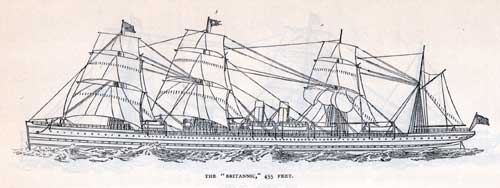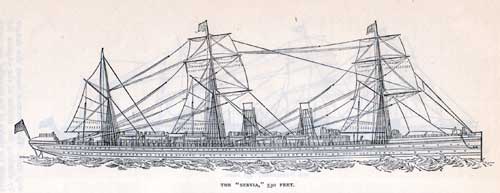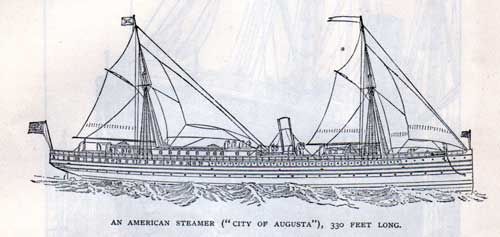The Screw Propeller and Adoption of Compound Marine Engine
1882 Ocean Steamships Article by S. G. W. Benjamin - Part 2
The possible value of the screw-propeller first began to be perceived and popularized by employing it as an auxiliary to sailing ships. In 1845 it was intended to establish an American line of auxiliary packet ships, but after the building of the Massachusetts the project was abandoned.
The employment of auxiliary screws in ships-of-war in the Crimean war indicated the tentative character of all previous uses of the propeller, while it revealed the possible value of this means of propulsion and the futility of any half-hearted use of the propeller in any service in which time is an important factor.
The steamship lines having the greatest competition to encounter are the very ones which carry the heaviest spars; owners know that they cannot afford to dispense with them in the face of a fierce rivalry. The frequency of broken shafts has often demonstrated the value of sails and rigging in steamships.
The adoption of the compound marine engine was another point which turned the scale in favor of propellers. The compound engine was invented by Hornblower in 1781. Allaire made such an engine for Eckford in 1825. The great feature of this type of marine engine is that the expansion of the steam is carried through two or more cylinders placed in succession; generally two cylinders are used.
The loss from the liquefaction of steam is thus greatly avoided and the framing and journals are eased of the tremendous strain to which they are subjected. The surface condenser, a comparatively recent improvement, has added greatly to the practicability of the marine steam-engine. Formerly condensation was produced by passing the steam into a condensing chamber, where it was met by a stream of cold water. Since the boilers were supplied with nearly salt water, it produced an incrustation, and high pressure steam was practically unsafe.
By the use of the surface condenser the steam is condensed by contact with tubes filled with a constant stream of cold water, and these difficulties are thus reduced to a minimum. The strain on the engines is also greatly relaxed in a storm by the delicate and beautiful invention called the marine governor, of which there are several varieties.
When the stern rises as the bow plunges into the hollow of a sea, the screw loses its hold on the water and as it returns again the shock to the machinery is of the most violent nature, hazarding not only the motive power but the safety of the ship itself. The governor meets this danger by checking the motion of the engines the instant the blades of the propeller rise above the surface.
By long, persevering effort means have been devised by which the consumption of fuel has been reduced to less than half what it was twenty years ago, while the improvements in naval architecture have developed greater speed. This has brought the steamship at once into rivalry with the sailing vessel, which held its own longer than it would have done but for the question of expense. The results have been astonishing.

The Steamship Britannic - 455 Feet
The Cunard line was established in 1840 with four steamers, the Britannia arriving in New York July 4th of that year. The four vessels aggregated only 4,602 tons. For a decade this was the only regular steamship line across the Atlantic. The Collins line of American steamships was founded in 185o, but being dependent, like other steam lines of the period, upon a subsidy ($858,000 per annum), was abandoned in 1858. The Inman line was established about 1856.
Our people are opposed to subsidies, and the tendency to corrupt and special legislation is so enormous in an active, enterprising democracy like ours, that there has been too much reason for this opposition; not, in our opinion, because the principle is a wrong one, but because it is liable to abuse. There is no question that the money judiciously expended by Great Britain in direct subsidies to ocean lines has been returned to her a thousand fold. This, however, does not involve the question of protection, which is quite a distinct matter.
We now see twelve first-rate lines of steam-packets plying between New York and Europe, besides a number of lines running to Boston, Baltimore, Philadelphia, and New Orleans, and not including a number of inferior lines whose name is legion, nor the other American coasting steamers extending as far as the Gulf of Mexico.

The Steamship Servia - 530 Feet
Although the majority of these vessels are foreign in construction and ownership, the American who has seen no other part of the seas but the North Atlantic may be led to the conclusion that the steamship traffic of the world centers on the great circle between Queenstown and New York, and that no other fine steamers exist elsewhere. He could not make a greater mistake.
Starting either from London or Liverpool and proceeding southward toward Gibraltar, one is astonished at the number of steamers he encounters. Across the Bay of Biscay they reach to the West Indies and Brazil, down the coast of Africa to the Cape of Good Hope or around the Horn, among the islands of the South Sea; or plowing through the Straits of Gibraltar and Suez, they reach to Mauritius and Bombay, Calcutta and Hong Kong.
Never has there been any such ownership of shipping in the United States like that of these English, French, and Italian lines. The Peninsular and Oriental Company (the first line to adopt the screw), Lamporte and Holt's line to South America, the Wilson line from Hull, the Cunard and Anchor lines (whose North Atlantic service is but a tithe of the vast trade they carry on with the Mediterranean and the East Indies), the Moss Steam-ship Company, the Rubattino line, the French Messageries Maritimes -- these are but a few of a host of lines which own ships by the score and the hundred.
The imagination is further bewildered in considering the vast lines plying in distant seas, and never heard of in this country. There is the British India Steam Navigation Company, owning over fifty steamers, which ply between Singapore, Persia, and Zanzibar, and are manned by tawny lascars; and the Netherlands Steam Navigation Company, which maintains thirty steamers in the Indian Archipelago.
Then there is a Chinese line, succeeding one established by an American company, and a Japanese company, whose steamships ply exclusively among the Japanese Isles. We can only allude to the Pacific Mail and numerous other lines sailing from San Francisco and developing every year in magnitude.
In 1881 the steam tonnage of Great Britain alone was 4,200,000 tons. But we have said enough to suggest the vast, almost incalculable spread of steam navigation within the last quarter of a century, or since the screw superseded the paddlewheel for ocean steamships.
Great modifications and improvements on old models have grown out of the employment of steam and the screw, and human invention has been taxed to the uttermost to combine economy of space and expense with the various needs of different climes, or special cargoes, or the demands of a traveling public that is growing more fastidious every day.

An American Steamer City of Augusta, 330 Feet Long.
The most obvious changes in naval construction have been in the greatly elongated hull, the enormous dimensions aimed at, and the all but universal employment of iron. When the first steamship crossed the ocean the proportions of ships averaged three to five beams in length. The war ships of Sir William Symonds were three to four beams long.
But extreme beam grew in favor owing to the sail-carrying power or stability it offers. The ancient galleys were long and narrow. A piratical galley was found imbedded on the coast of Schleswig, which had about the proportions of a modern steam-yacht. Robert L. Stevens was the first of modern builders, however, who foresaw that with the introduction of steam stability became of less moment, and he advocated a length of eight to nine beams.
The change in length was slow in coming, and has never been adopted by American naval architects to the extreme limits of some English steamers. But the change was inevitable for two reasons, and came at the last so rapidly that whole fleets of steamers were hauled up, cut in twain, and pieced out. One reason for this is found in the fact that men in this century sigh for a change of some sort. To follow the same track endlessly appears like retrogression.
Even a bad change is better than none, reasons the blind, unthinking public, while, on other hand, enterprise implies change. For this reason, more than because it is based on sense, there is now a reaction from this extreme form of model, for no very specific objection can be proved against it. Besides, it was discovered that with a given power and depth and beam the length could be increased without materially affecting the speed, thus adding to the carrying capacity of steam. Great length to beam, however, does not necessarily imply great speed; the speed of beamy vessels has too often been demonstrated.
